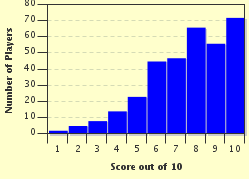Quiz Answer Key and Fun Facts
1. A Victorian-era novel, with a word in its title suggested by the hue of the accompanying single-coloured square, begins with this sentence: "The studio was filled with the rich odour of roses, and when the light summer wind stirred amidst the trees of the garden, there came through the open door the heavy scent of the lilac, or the more delicate perfume of the pink-flowering thorn". Who is the author of this novel?
2. An early American novel, with a word in its title suggested by something in the accompanying picture, begins with these lines: "On the human imagination, events produce the effects of time. Thus, he who has traveled far and seen much is apt to fancy that he has lived long; and the history that most abounds in important incidents, soonest assumes the aspect of antiquity." Who is the author of this novel?
3. A famous French book, with a couple of words in its title suggested by the accompanying photograph, begins with these words: "Three hundred and forty-eight years, six months, and nineteen days ago today, the Parisians awoke to the sound of all the bells in the triple circuit of the city, the university, and the town ringing a full peal". Who is the author of this novel?
4. Think of another Victorian novel. This one contains a last name, half of which is represented by the accompanying picture. The book begins with this opening line: "Whether I shall turn out to be the hero of my own life, or whether that station will be held by anybody else, these pages must show". Who is the author of this book?
5. This American-born author, who later became a British citizen, wrote a great number of novels, short stories, and works of literary criticism. One of his novellas, with a word represented by any one of the items in the accompanying photograph, begins with this line: "I remember the whole beginning as a succession of flights and drops, a little seesaw of the right throbs and the wrong". Who is the writer of this ghost story?
6. A Russian novella, with a word in its title suggested by the accompanying photograph, begins with these words: "I am a sick man. . . . I am a spiteful man." Who is the author of this story, which is considered by many to be one of the first existentialist stories?
7. The accompanying photograph suggests a word that is part of a name within the title of yet one more Victorian novel. The story begins thusly: "One evening of late summer, before the nineteenth century had reached one-third of its span, a young man and woman, the latter carrying a child, were approaching the large village of Weydon-Priors, in Upper Wessex, on foot". Who is the author and poet responsible for writing this novel?
8. An American novel, with a word in its title represented by the image in the accompanying photograph, opens with the following: "The cold passed reluctantly from the earth, and the retiring fogs revealed an army stretched out on the hills, resting". Who is the author of this book?
9. This 1864 French novel, with a word in its title suggested by the accompanying image, opens with these words: "Looking back to all that has occurred to me since that eventful day, I am scarcely able to believe in the reality of my adventures". Who is this book's author?
10. An American novel, with a word in its title suggested by the accompanying image, starts with the following line: "It was in Warwick Castle that I came across the curious stranger whom I am going to talk about". What is the name of the author of this work?
Source: Author
alaspooryoric
This quiz was reviewed by FunTrivia editor
looney_tunes before going online.
Any errors found in FunTrivia content are routinely corrected through our feedback system.


